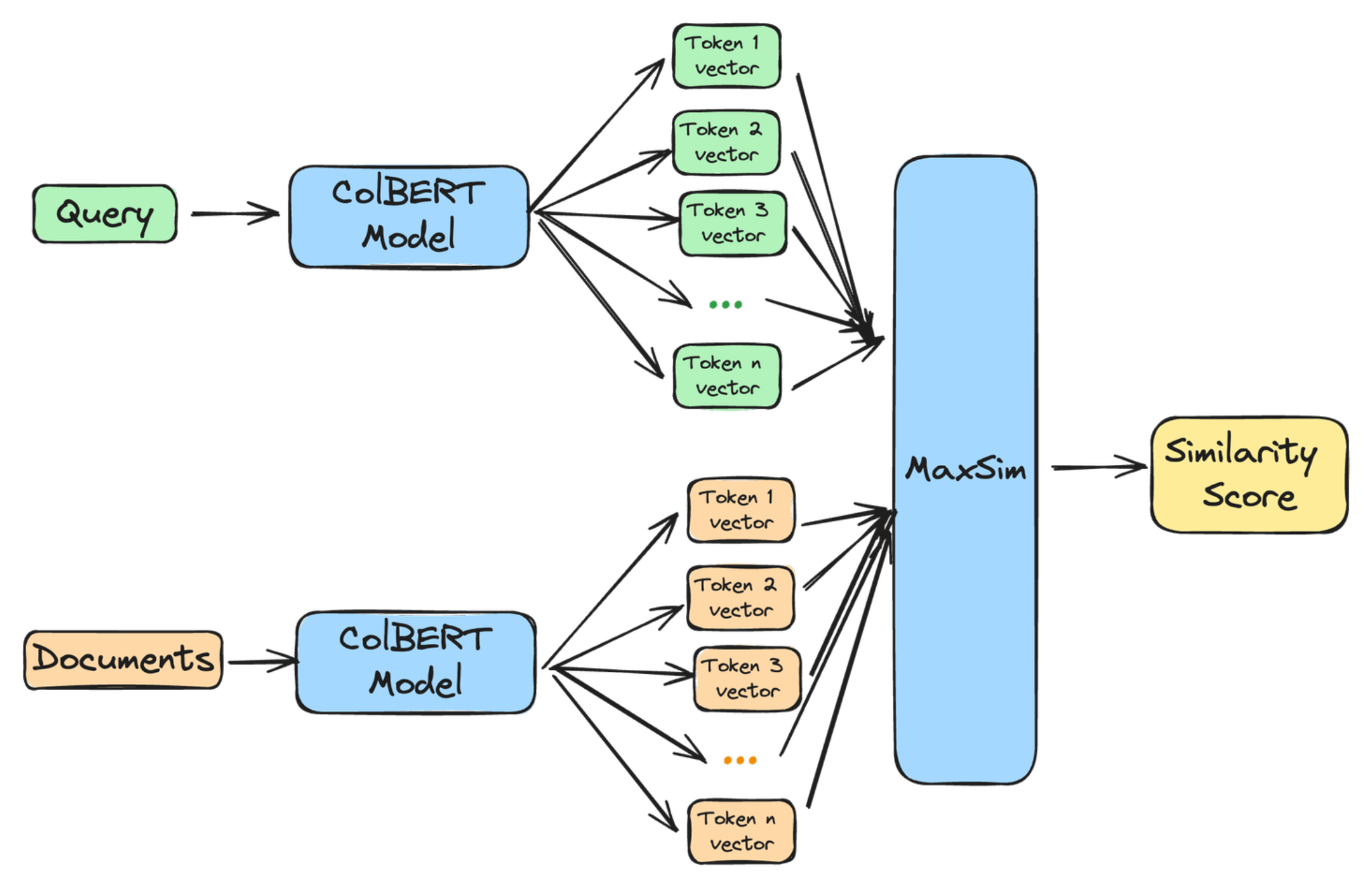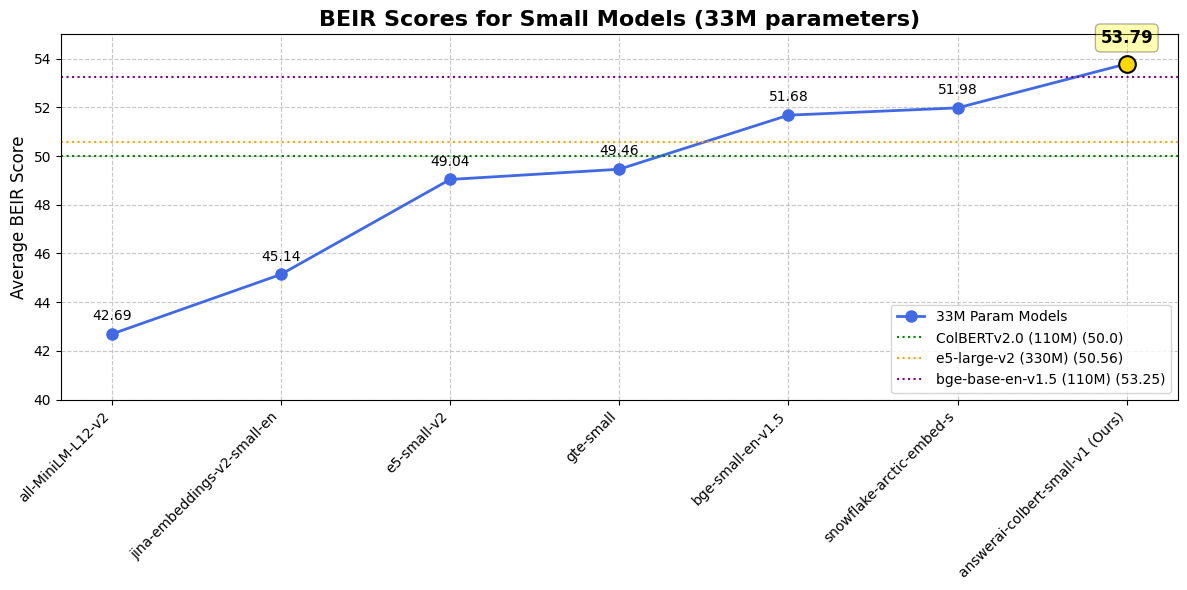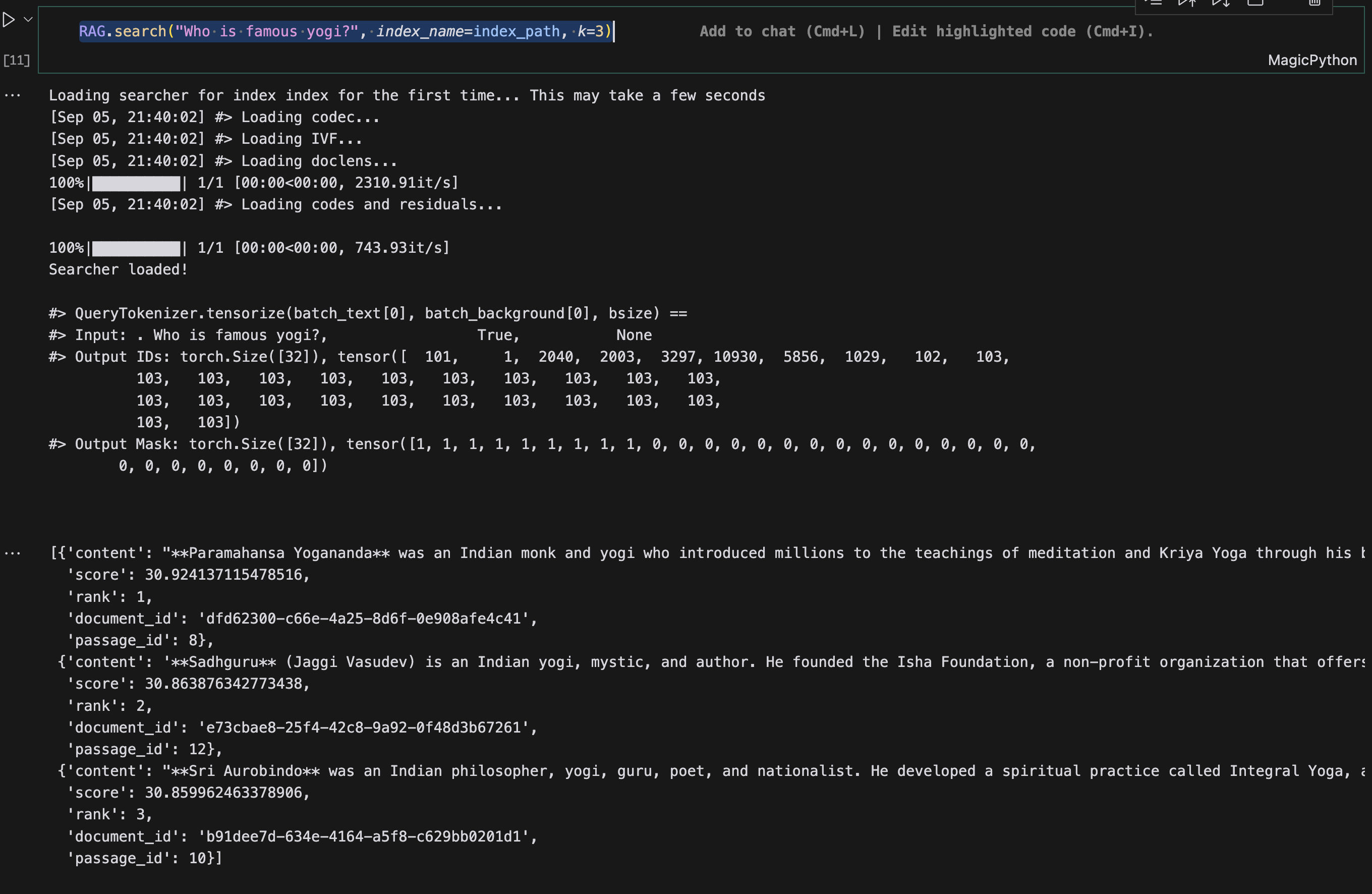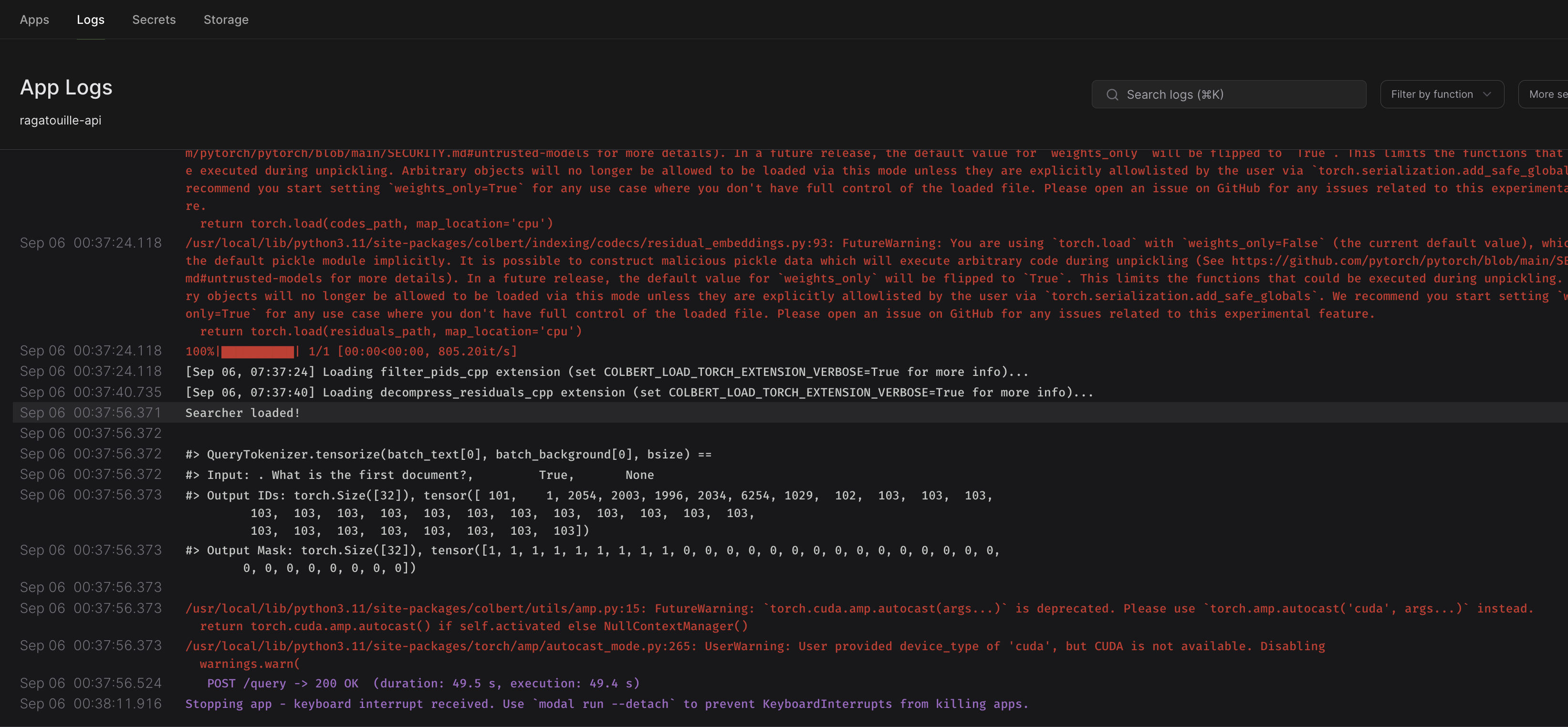
Concept to Code - Deploying ColBERT with RAGatouille on Modal Labs in Minutes
- 26 minsHello Everyone,
In my work with information retrieval systems, I’ve often come across a dilemma: should I use dense embeddings or sparse embeddings?
Dense embeddings, created by transformer networks, capture the semantic meaning of text in compact, continuous vectors, which is incredibly powerful when we want to understand context and nuance. On the other hand, sparse embeddings, generated by methods like TF-IDF or BM25, focus on the presence of specific words or terms, making them better at pinpointing exact matches.
The ideal solution would combine the strengths of both. We want the broad understanding of dense embeddings and the precise keyword matching of sparse embeddings.
That’s where ColBERT (Contextualized Late Interaction over BERT) comes into play, and I think it’s a game-changer. ColBERT offers the best of both worlds by using dense embeddings while also preserving some of the precision we see with sparse methods. What makes ColBERT unique is its late interaction mechanism, which allows it to perform more detailed, term-level matching after generating embeddings, unlike standard dense models that blend everything upfront. And its downloaded over 4.5M times in last month on huggingface🤯.

ColBERT excels at understanding the context of a query while also ensuring that important keywords are considered. This makes it a powerful tool for various tasks, from analyzing contracts to searching technical documents, as it offers both a deep understanding of meaning and precise keyword matching.
Discovering RAGatouille: Making ColBERT Accessible
About six months ago, I was introduced to a tool called RAGatouille by Simon Wilson, and it sent me down a rabbit hole of learning about ColBERT. What’s exciting about RAGatouille is that it makes working with ColBERT so much easier. Instead of dealing with the complexity of training a retrieval model from scratch, RAGatouille simplifies the entire process, allowing me to implement cutting-edge retrieval methods in just a few lines of code.
RAGatouille simplifies data preparation for training and easily handles large datasets. It automatically structures training data and compresses indices for storage.
And the best part? It’s super easy to implement. You can get ColBERT up and running in your retrieval pipeline with just a few lines of code, thanks to the streamlined design of RAGatouille. There’s even a lite version coming soon, which promises to make things even more lightweight and user-friendly.
In the next section, I’ll dive into how to use RAGatouille to build and query a ColBERT index, showing you how quickly you can start improving your retrieval tasks with this powerful tool.
Install RAGatouille
I prefer to use uv for package installations these days. It’s a great tool, and I highly recommend giving it a try if you haven’t already. Installing uv is straightforward: simply use pip install uv, just like installing Chrome on a new Windows laptop.
uv pip install ragatouille
I have been running this on my local mac, if you have gpu its even more faster.
ColBERT Model Sizes: A Tale of Two Models
When it comes to ColBERT, you have options! The original ColBERTv2 model boasts around 110 million parameters, making it a medium-sized player in the embedding world.
However, a newer, leaner ColBERT model has entered the scene: “answerai-colbert-small-v1”. This compact version weighs in at just 33 million parameters, falling within the “MiniLM-size range” – what we usually consider “small” for embedding models.

The smaller 33M parameter ColBERT model offers significant advantages:
- Faster Training: It trains much quicker, speeding up experimentation.
- Faster Queries: Enjoy rapid query responses, ideal for most use cases.
- Easier Deployment: Deploy on CPUs for inference, simplifying infrastructure.
- Cheaper Fine-tuning: Fine-tune it affordably, adapting it to your domain.
- Strong Performance: Despite its size, it often outperforms the larger 110M model.
We will be using this model for our implementation today
Building a ColBERT Index with RAGatouille
first thing first impport and downloading model from huggingface
from ragatouille import RAGPretrainedModel
RAG = RAGPretrainedModel.from_pretrained("answerdotai/answerai-colbert-small-v1")
Now lets define sample docs. here we are using list but you can use any type of list documents here for indexing
docs = [
"Hayao Miyazaki is a Japanese director, born on January 5, 1941, in Tokyo, Japan. He is a co-founder of Studio Ghibli and is known for his works such as 'Spirited Away', 'My Neighbor Totoro', and 'Princess Mononoke'. Miyazaki is celebrated for his unique storytelling and animation style, which often includes themes of nature, pacifism, and feminism.",
"Walt Disney is an American entrepreneur, animator, and film producer, born on December 5, 1901, in Chicago, Illinois. He is the co-founder of The Walt Disney Company and is best known for creating iconic characters like Mickey Mouse and producing classic animated films such as 'Snow White and the Seven Dwarfs', 'Cinderella', and 'The Lion King'. Disney's work has had a profound impact on the entertainment industry and popular culture.",
"Isao Takahata was a Japanese director and producer, born on October 29, 1935, in Ise, Japan. He co-founded Studio Ghibli with Hayao Miyazaki and directed several critically acclaimed films, including 'Grave of the Fireflies', 'The Tale of the Princess Kaguya', and 'Only Yesterday'. Takahata's films are known for their emotional depth and social commentary.",
"John Lasseter is an American animator, director, and producer, born on January 12, 1957, in Hollywood, California. He was a key figure in the development of computer-animated films and served as the Chief Creative Officer at Pixar and Walt Disney Animation Studios. Lasseter directed and produced several successful films, including 'Toy Story', 'A Bug's Life', and 'Cars'. His work has been instrumental in shaping the modern animation industry.",
"Osamu Tezuka, often referred to as the 'God of Manga', was a Japanese manga artist, animator, and film producer, born on November 3, 1928, in Toyonaka, Japan. He is best known for creating the manga series 'Astro Boy', 'Black Jack', and 'Phoenix'. Tezuka's work laid the foundation for modern manga and anime, and he is credited with pioneering many of the techniques and conventions that are now standard in the industry.",
"Chuck Jones was an American animator, director, and screenwriter, born on September 21, 1912, in Spokane, Washington. He is best known for his work on the Looney Tunes and Merrie Melodies series of cartoons, where he created iconic characters such as Bugs Bunny, Daffy Duck, and Wile E. Coyote. Jones's work is celebrated for its wit, humor, and innovative animation techniques.",
"Mamoru Hosoda is a Japanese film director and animator, born on September 19, 1967, in Toyama, Japan. He is known for directing films such as 'The Girl Who Leapt Through Time', 'Summer Wars', and 'Wolf Children'. Hosoda's films often explore themes of family, technology, and the passage of time, and he is considered one of the leading figures in contemporary Japanese animation.",
"Glen Keane is an American animator, author, and illustrator, born on April 13, 1954, in Philadelphia, Pennsylvania. He is best known for his work at Walt Disney Animation Studios, where he animated characters such as Ariel in 'The Little Mermaid', Beast in 'Beauty and the Beast', and Aladdin in 'Aladdin'. Keane's work is renowned for its expressiveness and emotional depth, and he has been a major influence on the field of character animation.",
"**Paramahansa Yogananda** was an Indian monk and yogi who introduced millions to the teachings of meditation and Kriya Yoga through his book, 'Autobiography of a Yogi'. He established the Self-Realization Fellowship (SRF) to disseminate his teachings worldwide.",
"**Swami Vivekananda** was a key figure in the introduction of Vedanta and Yoga to the Western world. He was a disciple of Ramakrishna Paramahamsa and is known for his inspiring lectures and speeches on spirituality and Indian philosophy.",
"**Sri Aurobindo** was an Indian philosopher, yogi, guru, poet, and nationalist. He developed a spiritual practice called Integral Yoga, aiming for a divine life on earth. He also played a significant role in India's struggle for independence.",
"**Ramana Maharshi** was an Indian Hindu sage who advocated for self-enquiry as the principal means to achieve liberation. He is known for his teachings on Advaita Vedanta and his simple yet profound approach to spirituality.",
"**Sadhguru** (Jaggi Vasudev) is an Indian yogi, mystic, and author. He founded the Isha Foundation, a non-profit organization that offers yoga programs around the world and is involved in social outreach, education, and environmental initiatives."
]
Now lets index the data. indexing is very easy with ragatouille in single line you can create a local index
index_path = "index"
RAG.index(
collection=docs,
index_name=index_path,
max_document_length=512,
split_documents=True,
# use_faiss=True, # use only when you can sure that faiss is working on your system
)
As you can see, we’ve used split_documents=True. This splits documents into smaller chunks to fit the model’s input size, which is helpful for large documents. We’ve also set max_document_length=512, which controls the maximum size of these chunks.
Now, let’s preload the saved index and query it.
RAG = RAGPretrainedModel.from_index(".ragatouille/colbert/indexes/index")
RAG.search("Who is famous yogi?", index_name=index_path, k=3)
This should return the top 3 documents from the indexed documents. 
In just a few lines of code, you have implemented a ColBERT model with Ragatouille. This demonstrates how easy it is to use ColBERT with Ragatouille.
However, there are no guides to how put this in production. So here we go, we will be creating fast api server to serve this model first and we will also use some modification to deploy the same server on modal labs.
FastAPI Server for ColBERT
Lets get started with fastapi server. First we will install fastapi and uvicorn
uv pip install fastapi uvicorn
Now lets create a server file server.py and add the following code
from fastapi import FastAPI, HTTPException
from pydantic import BaseModel
from typing import List
from ragatouille import RAGPretrainedModel
We would be using best practice of fast api and create a pydantic model for our request and response
class Query(BaseModel):
text: str
k: Optional[int] = 1 # default k=1
class Response(BaseModel):
answer: List
class Document(BaseModel):
id: str
text: str
class IndexRequest(BaseModel):
index_name: str
documents: List[Document]
class IndexResponse(BaseModel):
message: str
index_path: str
We have created 5 pydantic objects:
Query: This object represents the query that the user will send to the server. It has a single fieldtextwhich is the query string.Response: This object represents the response that the server will send back to the user. It has a single fieldanswerwhich is the answer to the query.Document: This object represents a document that will be indexed. It has two fieldsidwhich is the unique identifier of the document andtextwhich is the text of the document.IndexRequest: This object represents the request to index a set of documents. It has two fieldsindex_namewhich is the name of the index anddocumentswhich is a list ofDocumentobjects.IndexResponse: This object represents the response to the index request. It has two fieldsmessagewhich is a message indicating whether the indexing was successful andindex_pathwhich is the path to the index.
Now lets create create index endpoint,
@app.post("/create_index", response_model=IndexResponse)
async def create_index_endpoint(request: IndexRequest):
try:
docs = [{"id": doc.id, "text": doc.text} for doc in request.documents]
rag = RAGPretrainedModel.from_pretrained("answerdotai/answerai-colbert-small-v1")
docs = [doc.text for doc in request.documents]
rag.index(
collection=docs,
index_name=request.index_name,
max_document_length=512,
split_documents=True,
# use_faiss=True, # use only when you can sure that faiss is working on your system
)
return IndexResponse(
message="Index created successfully",
index_path=request.index_name
)
except Exception as e:
raise HTTPException(status_code=500, detail=str(e))
This endpoint, which we can access through a POST request to /create_index, is designed to create a new index of documents using our RAG model.
It receives a list of documents, transforms them into the format our model expects, and then uses the rag.index function to actually build the index.
Finally we will implement query endpoint.
@app.post("/query", response_model=Response)
async def query_endpoint(query: Query, index_name: str):
try:
rag = RAGPretrainedModel.from_index(f".ragatouille/colbert/indexes/{index_name}")
results = rag.search(query.text, k=query.k)
return Response(answer=results)
except Exception as e:
raise HTTPException(status_code=500, detail=str(e))
This endpoint, accessible via a POST request to /query, handles user queries against a specific index.
It takes the user’s query and the name of the index to search as input. It then uses the rag.search function to retrieve the most relevant document from the specified index.
Finally, it extracts the text content of the most relevant result and returns it as the answer to the user’s query.
to run this server we can create a main.py file and add the following code
if __name__ == "__main__":
import uvicorn
uvicorn.run("server:app", host="0.0.0.0", port=8000)
Now you can run the server using the following command
python main.py
This will start the server on http://0.0.0.0:8000. You can test the endpoints using a tool like curl or Postman.
Testing the Server
We can use requests library to test the server. Here is a sample test code for creating index and querying the index.
import requests
def test_create_index():
response = requests.post(
"http://localhost:8000/create_index",
json={
"index_name": "my_index",
"documents": [
{"id": "doc1", "text": "**Paramahansa Yogananda** was an Indian monk and yogi who introduced millions to the teachings of meditation and Kriya Yoga through his book, 'Autobiography of a Yogi'. He established the Self-Realization Fellowship (SRF) to disseminate his teachings worldwide."},
{"id": "doc2", "text": "**Swami Vivekananda** was a key figure in the introduction of Vedanta and Yoga to the Western world. He was a disciple of Ramakrishna Paramahamsa and is known for his inspiring lectures and speeches on spirituality and Indian philosophy."},
{"id": "doc3", "text": "**Sri Aurobindo** was an Indian philosopher, yogi, guru, poet, and nationalist. He developed a spiritual practice called Integral Yoga, aiming for a divine life on earth. He also played a significant role in India's struggle for independence."},
{"id": "doc4", "text": "**Ramana Maharshi** was an Indian Hindu sage who advocated for self-enquiry as the principal means to achieve liberation. He is known for his teachings on Advaita Vedanta and his simple yet profound approach to spirituality."},
{"id": "doc5", "text": "**Sadhguru** (Jaggi Vasudev) is an Indian yogi, mystic, and author. He founded the Isha Foundation, a non-profit organization that offers yoga programs around the world and is involved in social outreach, education, and environmental initiatives."}
]
},
)
assert response.status_code == 200
assert response.json()["message"] == "Index created successfully"
def test_query_index():
response = requests.post(
"http://localhost:8000/query",
json={"text": "What is the first document?", "k": 3},
params={"index_name": "my_index"},
)
print(response.json())
assert response.status_code == 200
This was easy to create, right? Now let’s deploy it on Modal Labs! ColBERT’s speed relies on GPUs, and Modal’s serverless GPU setup is perfect for it. I chose Modal because it’s super easy to deploy, offers various GPU options like A100s, automatically scales to handle demand, and is cost-effective since I only pay for what I use. Plus, it’s fast and flexible, letting me focus on my code instead of infrastructure.
Let’s first install Modal on your system using pip:
uv pip install modal
Make sure you do necessary setup and create account on modal labs. here is the link
to use our FastAPI server inside Modal, we need to make some necessary changes to our server.py file. We’ll create a new file, modal_server.py, and add the following code.
What are changes we need to make in our server.py file to make it work on modal labs?
Let’s break down the changes we need to make to our server.py file to deploy it on Modal Labs.
1. Importing Modal:
We start by importing the modal library, which provides the tools for interacting with Modal’s platform.
import modal
2. Defining a Modal Image:
Next, we define a Modal image. This image will encapsulate our application’s environment, including Python and the necessary libraries. We’ll use a Debian Slim base image with Python 3.11 and install fastapi, pydantic, and ragatouille using pip_install. Additionally, we’ll install git using apt_install.
To optimize performance and reduce cold start times, we’ll download the required NLTK data and the RAG model during the image build process. This is achieved by defining two custom functions, download_nltk_data and download_model, and then using run_function to execute them within the image definition. By doing so, these resources will be readily available when the application starts, eliminating the need to download them at runtime.
def download_nltk_data():
import nltk
nltk.download('punkt')
def download_model():
from ragatouille import RAGPretrainedModel
rag = RAGPretrainedModel.from_pretrained("answerdotai/answerai-colbert-small-v1")
# Create an ima
image = (
modal.Image.debian_slim(python_version="3.11")
.pip_install("fastapi", "pydantic", "ragatouille")
.apt_install("git")
.run_function(download_nltk_data)
.run_function(download_model)
)
3. Creating a Modal Volume:
We’ll create a Modal volume to persistently store our RAG indexes. This ensures that our indexes are not lost between function invocations.
volume = modal.Volume.from_name("ragatouille-indexes", create_if_missing=True)
4. Defining a Modal App:
We define a Modal app named ragatouille-api, associating it with the image and volume we created. This app will serve as the container for our FastAPI server.
app = modal.App("ragatouille-api", image=image,volumes={"/ragatouille_indexes": volume})
5. Decorating Endpoints with @app.function:
We decorate our create_index_endpoint and query_endpoint with @app.function. This tells Modal that these functions should be executed as serverless functions within our Modal app. We specify the image to use, the GPU type (“T4” in this case), and a timeout for the functions.
@app.function(image=image, timeout=3600)
@app.post("/create_index", response_model=IndexResponse)
async def create_index_endpoint(request: IndexRequest):
@app.function(image=image, timeout=3600)
@app.post("/query", response_model=Response)
async def query_endpoint(query: Query, index_name: str):
6. Creating an ASGI App:
We define a function fastapi_app decorated with @app.function and @modal.asgi_app(). This function returns our FastAPI app instance, making it accessible as an ASGI application within Modal.
@app.function(image=image)
@modal.asgi_app()
def fastapi_app():
return app
Putting it all together, here’s the complete code for modal_server.py:
from fastapi import FastAPI, HTTPException
from pydantic import BaseModel
from typing import List, Optional
from ragatouille import RAGPretrainedModel
# Import modal
import modal
def download_nltk_data():
import nltk
nltk.download('punkt')
def download_model():
from ragatouille import RAGPretrainedModel
rag = RAGPretrainedModel.from_pretrained("answerdotai/answerai-colbert-small-v1")
image = (
modal.Image.debian_slim(python_version="3.11")
.pip_install("fastapi", "pydantic", "ragatouille")
.apt_install("git")
.run_function(download_nltk_data)
.run_function(download_model)
)
# Create a Modal volume to store indexes
volume = modal.Volume.from_name("ragatouille-indexes", create_if_missing=True)
app = modal.App("ragatouille-api", image=image,volumes={"/ragatouille_indexes": volume})
fast_app = FastAPI()
class Query(BaseModel):
text: str
k: Optional[int] = 1 # default k=1
class Response(BaseModel):
answer: List
class Document(BaseModel):
id: str
text: str
class IndexRequest(BaseModel):
index_name: str
documents: List[Document]
class IndexResponse(BaseModel):
message: str
index_path: str
# Initialize the RAG model
@app.function(image=image, timeout=3600)
@fast_app.post("/create_index", response_model=IndexResponse)
async def create_index_endpoint(request: IndexRequest):
try:
# Remove print statements
# print("Received request:", request)
# print("Request type:", type(request))
# print("Documents:", request.documents)
# print("First document type:", type(request.documents[0]) if request.documents else "No documents")
docs = [{"id": doc.id, "text": doc.text} for doc in request.documents]
rag = RAGPretrainedModel.from_pretrained("answerdotai/answerai-colbert-small-v1")
docs = [doc.text for doc in request.documents]
rag.index(
collection=docs,
index_name=request.index_name,
max_document_length=512,
split_documents=True,
use_faiss=True, # use only when you can sure that faiss is working on your system
)
return IndexResponse(
message="Index created successfully",
index_path=request.index_name
)
except Exception as e:
# Remove print statements
# print(e)
raise HTTPException(status_code=500, detail=str(e))
@app.function(image=image, timeout=3600)
@fast_app.post("/query", response_model=Response)
async def query_endpoint(query: Query, index_name: str):
try:
# Remove print statements
# print("Received query:", query)
# print("Index name:", index_name)
rag = RAGPretrainedModel.from_index(f".ragatouille/colbert/indexes/{index_name}")
results = rag.search(query.text, k=query.k)
return Response(answer=results)
except Exception as e:
raise HTTPException(status_code=500, detail=str(e))
@app.function(image=image)
@modal.asgi_app()
def fastapi_app():
return fast_app

You can test this by running the following command:
modal serve modal_server.py
Then, replace localhost in your API requests with your Modal endpoint. For example, my endpoint is: <username>--ragatouille-api--fastapi-app-dev.modal.run Replace <username> with your Modal username.
And that’s it! You’ve successfully deployed your FastAPI server with ColBERT on Modal Labs. You can now use this server to create and query indexes with RAGatouille.
Conclusion
This post showed how to use ColBERT and RAGatouille for information retrieval. We deployed our system on Modal Labs to make it faster and easier to scale. While we wanted to use Modal’s GPUs, we ran into some issues and used CPUs instead. We’ll discuss these challenges in a future post.
This setup offers a robust and efficient solution for various information retrieval tasks, particularly when dealing with large datasets and complex queries. Whether your focus is semantic search, question answering, or other applications demanding advanced retrieval capabilities, the combination of ColBERT, RAGatouille, and Modal Labs can significantly enhance your workflow.
I encourage you to experiment with this setup and discover the possibilities it unlocks for your information retrieval projects. Feel free to reach out if you have any questions or want to share your experiences. Happy coding!
Code can be found here
P.S. Remember that deploying a FastAPI server without authentication in a production environment is not recommended. Consider integrating authentication mechanisms, such as those provided by fastapi-auth, to secure your application. You can find more information on FastAPI authentication in the official documentation.
References
- ColBERT Hugging Face Model: ColBERT
- Simon Wilson’s ColBERT with RAGatouille TIL: Simon Wilson
- RAGatouille Lite Version Announcement: lite version coming soon
- AnswerAI’s Small ColBERT Model Blog Post: “answerai-colbert-small-v1”
- Code Repository for this Blog Post: Code Implementation
- Modal Labs Documentation: Modal Docs
- FastAPI Authentication Documentation: FastAPI Security
- Interesting Talk on Colbert: Ben Clavie’s Talk